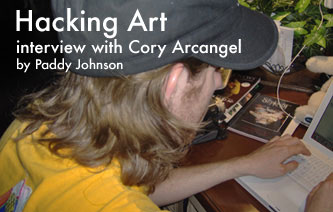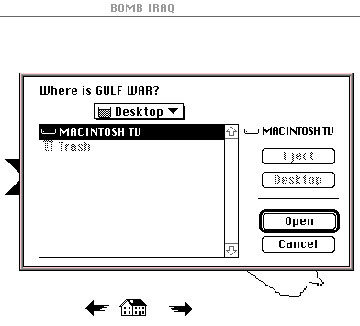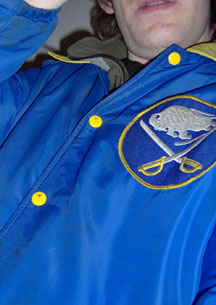Hacking Art: Interview with Cory Arcangel
27.03.06
 I hadn’t seen new media artist Cory Arcangel in close to three years, but when we got together again recently for the purpose of an interview, he was wearing the same Buffalo Sabers jacket he had on when we first met at Harvestworks in 2000. Admittedly, Arcangel’s choice of wardrobe has not been a popular point of discussion among the press, so there may be some question as to the relevance this has to the following interview. I will attempt to answer this by beginning with the disclaimer that, in truth, it may be no more than idiosyncratic behavior, but, at the time I couldn’t help but make a connection between his standing interest in Sabers outer wear, and his similarly specific and long time engagement in such things as metal bands, Google, and “hacking.” Since the majority of subjects that attract the artist eventually become part of his work, it is quite possible that a Google hack that brings back only winning game results of the Sabres Hockey team in the year Black Sabbath broke up is next on the artist’s slate to complete. Of course, there is no need to label this as a prediction.
I hadn’t seen new media artist Cory Arcangel in close to three years, but when we got together again recently for the purpose of an interview, he was wearing the same Buffalo Sabers jacket he had on when we first met at Harvestworks in 2000. Admittedly, Arcangel’s choice of wardrobe has not been a popular point of discussion among the press, so there may be some question as to the relevance this has to the following interview. I will attempt to answer this by beginning with the disclaimer that, in truth, it may be no more than idiosyncratic behavior, but, at the time I couldn’t help but make a connection between his standing interest in Sabers outer wear, and his similarly specific and long time engagement in such things as metal bands, Google, and “hacking.” Since the majority of subjects that attract the artist eventually become part of his work, it is quite possible that a Google hack that brings back only winning game results of the Sabres Hockey team in the year Black Sabbath broke up is next on the artist’s slate to complete. Of course, there is no need to label this as a prediction.
In contrast to the variety of the subject matters above that informs the work, Nintendo game hacks have been identified as the work Arcangel is best known for. This is an interesting media phenomenon to watch in light of the fact that it is not only a simplification, but misrepresentation of the real reasons he has become so well known. While it is likely that the game cartridges have greater value as commodity objects and therefore have been pushed by galleries, Arcangel’s audience has never been limited to the contemporary gallery scene. Dirt Style Design is one example of a better-known piece by the artist, a term and a website (that no longer exists) that aims to teach people how to make the worst websites imaginable. While it is true that this aesthetic had been developing among many before Arcangel coined the term, he was the one to popularize it. Given that this online tutorial has basically inspired an entire field of working artists, I would argue that this piece has been at least more influential than the Nintendo hacks.
Perhaps more than any one work, though, Arcangel has garnered a reputation for his comic ability. It is a tool he has used from the beginning as a means of ensuring that some of the more complex ideas he works with are more palatable to those who don’t happen to be overly technologically inclined, and as such, our interview is a means not only of contextualizing some of his work, but to understand some of the deeper issues that inform Arcangel’s artistic production. So, although the blue jacket was brought out back in the fall, ultimately I didn’t see it again as the interview was conducted via email. For an artist who uses sites or mediums that are popular, a discussion via text message would probably have been the most appropriate thematically, but the restraints of that medium have proved too great for this interviewer.
 FANZINE: You have talked about the work you made at Oberlin College with Beige, such as the 8-bit construction set as being very formative. Beige did a number of other works too that I recall being quite interesting, but I don’t remember all of the projects now. What were some of those things?
FANZINE: You have talked about the work you made at Oberlin College with Beige, such as the 8-bit construction set as being very formative. Beige did a number of other works too that I recall being quite interesting, but I don’t remember all of the projects now. What were some of those things?
CORY ARCANGEL: We made the 8 bit Construction Set record which was a 12 inch DJ battle record with one side made on the Commodore 64 and the other on the Atari. Also, we made some videos for it, and we had (at the time) a regularly updated website, with plenty of "photo journals". Beige Records released a bunch of techno and experimental records and collaborated on a bunch of hacked Nintendo cartridges and other strange ASCII silk-screens. Basically we did whatever we thought was fun. Even the concept for the project Total Asshole Compression was an idea from the Beige days. Paul every year did the BEIGE cassette battle, which was a cassette DJ battle, which was WICKED fun.
FANZINE: We met when you first moved from Ohio to New York and were working at Harvestworks. Around this time you curated a RAM show that was through Moving Image Gallery and Rhizome.org. Was this your first introduction to Rhizome? Has this affected your work?
CORY: Yeah, I had almost forgotten about that. At the time Rhizome was hosting a night called "Open Mouse" at a club called FUN (does anyone remember that club???). The flyer for the show was a floppy with the information printed on the label, but nothing on the disks! I thought that was LAME, and therefore proposed to curate a show of stuff that was to be put on the floppy disk. Each submission had to be under a specific "size." I think it was under 32k?! I curated it with Michele Thursz, and it was done in collaboration with Rhizome and Moving Image Gallery, which Michelle ran at the time. It was my first real effort at doing stuff in NYC. And yeah, it did affect me, because I basically ended up curating a bunch of shows in NYC as a result, (the Infinite Fill show with my sister Jamie at Foxy Production, Psyche Out with Seth Price at Anthology Film Archives, and Another Bad Creation at Deitch Projects). More importantly I met a bunch of amazing media artists in NYC and these people have become very good friends.
 FANZINE: In fact it was a friend, Yael Kanarek, that organized your first talk in 2001 at Eyebeam. I remember this talk because you said some rather nasty things about Flash––the crux of your argument being that you should understand how a program is built if you are going to use it, and that Flash makes everything look the same. I saw your lecture at Columbia University in 2004 online, where you appear to have changed your opinion a little. Though you don’t speak specifically about Flash, you do mention that you now believe that as long as you understand software imposes an aesthetic then it is fine to work with it. What was it that made you change your mind?
FANZINE: In fact it was a friend, Yael Kanarek, that organized your first talk in 2001 at Eyebeam. I remember this talk because you said some rather nasty things about Flash––the crux of your argument being that you should understand how a program is built if you are going to use it, and that Flash makes everything look the same. I saw your lecture at Columbia University in 2004 online, where you appear to have changed your opinion a little. Though you don’t speak specifically about Flash, you do mention that you now believe that as long as you understand software imposes an aesthetic then it is fine to work with it. What was it that made you change your mind?
CORY ARCANGEL: Well in 2001, I was still a punk basically, and just thought it was my way or the highway. This was inherited from the BEIGE days, where we kinda rolled as a computer gang, and pretty much hated anything that wasn’t exactly like what we were doing. But I guess as we grew older we started seeing all this work that we loved that wasn’t necessarily 100% craft aware. In fact it was the opposite. I mean look at the Internet? How many amazing crappy Flash animations are there? And those are amazing!! Also, I began to see bad Photoshop art where the artist knew it was bad and was therefore OK. So I needed to find a way to accommodate this perspective…..otherwise I would be ruling out a lot of great self aware media art that is made these days. I had to have a way to deal with that in my own set of rules…
FANZINE: It’s interesting that you mention rules, because a popular method of working within the new media community tends to be to establish a set of parameters and then work within them. It seems to me that this is a natural response to the way a programmer works with the medium. For example, a recurring theme in your work is figuring out how to get small actions to have large results. Computer geeks seem to love this shit; a single line of code being the most efficient way of performing a single action. It’s also akin to playing video games, where pushing some button will blow up…say, Iraq. Interactive artist David Rokeby has described this experience as being a very ego gratifying experience for the user. I think your piece at Pace illustrated this rather nicely. I imagine though that this sort of philosophy leads people to criticize some of your work as "One-Liners". How do you respond to this?
CORY ARCANGEL: Yeah, I get this critique a lot, more and more lately. It is valid in a certain way. Though, from my perspective, I just laugh it off because those are the people who have no idea what I am doing or why. You know, my favorite works are things like Ed Ruscha’s “26 gas stations,” Alvin Lucier’s “Sitting in a room,” and even Andy Kaufman’s “Mighty Mouse”…I just have always loved process based algorithmic art; set some rules and let it go. I found this model works well for technology art because people have no way to relate to it anyway…therefore the simpler you can make it, the more people might actually have a chance of relating to it (note that I am not saying “like it,” only “understand it”). For years I made abstract computer art, and people’s eyes would just gloss over. But it makes sense. When people look at an abstract painting they know how paint works and therefore at least have an “in” when trying to figure out what the artist is getting at because at a certain point meaning relates to process. But with computer stuff, they just see a bunch of blinking lights, which is annoying. My work therefore tends to be simple to combat this situation. Plus, I am very inspired by Internet "memes" (the things that get forwarded to you by your friends) and actually worked in a R+D group for a year or so studying them, so this affected my art. You know, for something to get massively popular on the Internet IT HAS TO BE SIMPLE. And of course, what you say is also true. I have a programmer’s sense of simplicity. There is nothing that calms me down and makes me relaxed more than some well written code…so yeah, these “one liners” actually are a combination of these pretty far reaching concerns…
 FANZINE: Speaking of memes (at least the sense of something being read and copied) I counted 6 write ups on you over 4 pages of google searches on the net that begin with "Best known for his hacked Nintendo cartridges" or some permutation of this. Does this bother you at all?
FANZINE: Speaking of memes (at least the sense of something being read and copied) I counted 6 write ups on you over 4 pages of google searches on the net that begin with "Best known for his hacked Nintendo cartridges" or some permutation of this. Does this bother you at all?
CORY ARCANGEL: Yeah, it’s annoying. Somehow one article used that phrase and everyone copied and pasted it. It was really the Mario clouds that did it, because that was the work that everyone ended up hearing about. The reason it is annoying is because, of course, I am not the only one making these things. Also, I tend to do quite a bit more, but people are too lazy to figure it out. I mean in a way I like it, because it sets up a really fun situation in lectures where people are expecting me to talk about computer stuff, and then I go and talk about Simon and Garfunkel for an hour. In certain respects it makes it much easier to confuse people.
FANZINE: You said once that nothing in your mind has any significance unless it is attached to some sort of pop culture stuff, and of course the Simon and Garfunkel piece is a good example of this. It reminds me of how you once said that entertainment is what made people pay attention to things. How far do you think this extends? At what point does entertainment not provide enough for you?
CORY ARCANGEL: As far as I am concerned, entertainment as source material can provide everything one needs…though of course entertainment doesn’t even come close to saying all the things that need to be said, but as an artist one can use this absence to say the remaining.
FANZINE: Given entertainment as a model has become so popular, it’s not a surprise that artists such as yourself who do interesting things with the medium have become a lot better known. Do you feel more pressure now that The Economist has quoted you? Are you recognized on the street now? Have you been in an elevator when someone was talking about your work, but didn’t know you had made it?
CORY ARCANGEL: No, I haven’t been recognized in an elevator (laughs)! Though I do feel more pressure, at least in terms of people’s expectations. At this point I am really expected to make a certain thing (minimal pop computer projections), but of course this is not always my interest…
FANZINE: But web surfing certainly is. The Atari 800 Laptop is listed on the 2005 top ten things on the web. Did you make this, or someone else? What is it made of––I mean is it an Atari system––does it only do simple word processing? Does it have a calculator?––because that would make it very useful.
CORY ARCANGEL: Yeah I surf the web for like HOURS a day…as for that laptop, someone else made it. It is an old Atari 800 home computer that someone stuffed into a laptop form, and therefore someone can take it with him. Of course there is no reason for this. But I love obsessive-compulsive web behavior. In a lot of ways that is what many of my projects are based on (Eddie Van Halen Guitar lecture, Nintendo hacking stuff…). There are just so many people out there with these niche interests making amazing stuff, it really is difficult to keep focused…and yes, it does have a calculator, but you need to program it yourself in BASIC!
FANZINE: In addition to your ongoing web surfing projects, what do you have coming up in the future?
CORY ARCANGEL: Well, I am showing new stuff at Galerie Thaddeus in Paris that opens on the 23rd of March. I just made a 2 month long version of the movie COLORS where I play it as one horizontal line of pixels at a time (they are stretched to the top and bottom of the screen). Also I am working on a webpage that featured Kurt Cobain’s suicide letter with Google ads that are generated from the text of the letter. I just had the song "Sailing" by Christopher Cross translated into Arabic. So yeah, I am as busy as usual!!!!!!
LINKS:
Beige: www.beigerecords.com
Total Asshole compression: www.taccompression.com
Bomb Iraq: http://www.artlist.biz/bomb_iraq.gif